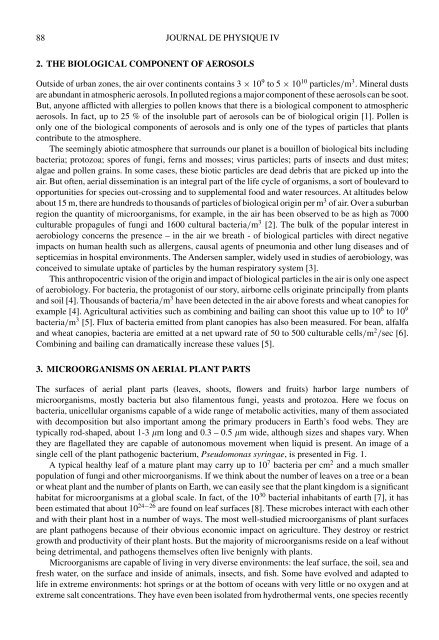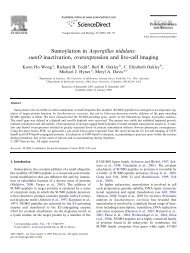Ice nucleation active bacteria and their potential role in precipitation
Ice nucleation active bacteria and their potential role in precipitation
Ice nucleation active bacteria and their potential role in precipitation
You also want an ePaper? Increase the reach of your titles
YUMPU automatically turns print PDFs into web optimized ePapers that Google loves.
88 JOURNAL DE PHYSIQUE IV<br />
2. THE BIOLOGICAL COMPONENT OF AEROSOLS<br />
Outside of urban zones, the air over cont<strong>in</strong>ents conta<strong>in</strong>s 3 × 10 9 to 5 × 10 10 particles/m 3 . M<strong>in</strong>eral dusts<br />
are abundant <strong>in</strong> atmospheric aerosols. In polluted regions a major component of these aerosols can be soot.<br />
But, anyone afflicted with allergies to pollen knows that there is a biological component to atmospheric<br />
aerosols. In fact, up to 25 % of the <strong>in</strong>soluble part of aerosols can be of biological orig<strong>in</strong> [1]. Pollen is<br />
only one of the biological components of aerosols <strong>and</strong> is only one of the types of particles that plants<br />
contribute to the atmosphere.<br />
The seem<strong>in</strong>gly abiotic atmosphere that surrounds our planet is a bouillon of biological bits <strong>in</strong>clud<strong>in</strong>g<br />
<strong>bacteria</strong>; protozoa; spores of fungi, ferns <strong>and</strong> mosses; virus particles; parts of <strong>in</strong>sects <strong>and</strong> dust mites;<br />
algae <strong>and</strong> pollen gra<strong>in</strong>s. In some cases, these biotic particles are dead debris that are picked up <strong>in</strong>to the<br />
air. But often, aerial dissem<strong>in</strong>ation is an <strong>in</strong>tegral part of the life cycle of organisms, a sort of boulevard to<br />
opportunities for species out-cross<strong>in</strong>g <strong>and</strong> to supplemental food <strong>and</strong> water resources. At altitudes below<br />
about 15 m, there are hundreds to thous<strong>and</strong>s of particles of biological orig<strong>in</strong> per m 3 of air. Over a suburban<br />
region the quantity of microorganisms, for example, <strong>in</strong> the air has been observed to be as high as 7000<br />
culturable propagules of fungi <strong>and</strong> 1600 cultural <strong>bacteria</strong>/m 3 [2]. The bulk of the popular <strong>in</strong>terest <strong>in</strong><br />
aerobiology concerns the presence – <strong>in</strong> the air we breath - of biological particles with direct negative<br />
impacts on human health such as allergens, causal agents of pneumonia <strong>and</strong> other lung diseases <strong>and</strong> of<br />
septicemias <strong>in</strong> hospital environments. The Andersen sampler, widely used <strong>in</strong> studies of aerobiology, was<br />
conceived to simulate uptake of particles by the human respiratory system [3].<br />
This anthropocentric vision of the orig<strong>in</strong> <strong>and</strong> impact of biological particles <strong>in</strong> the air is only one aspect<br />
of aerobiology. For <strong>bacteria</strong>, the protagonist of our story, airborne cells orig<strong>in</strong>ate pr<strong>in</strong>cipally from plants<br />
<strong>and</strong> soil [4]. Thous<strong>and</strong>s of <strong>bacteria</strong>/m 3 have been detected <strong>in</strong> the air above forests <strong>and</strong> wheat canopies for<br />
example [4]. Agricultural activities such as comb<strong>in</strong><strong>in</strong>g <strong>and</strong> bail<strong>in</strong>g can shoot this value up to 10 6 to 10 9<br />
<strong>bacteria</strong>/m 3 [5]. Flux of <strong>bacteria</strong> emitted from plant canopies has also been measured. For bean, alfalfa<br />
<strong>and</strong> wheat canopies, <strong>bacteria</strong> are emitted at a net upward rate of 50 to 500 culturable cells/m 2 /sec [6].<br />
Comb<strong>in</strong><strong>in</strong>g <strong>and</strong> bail<strong>in</strong>g can dramatically <strong>in</strong>crease these values [5].<br />
3. MICROORGANISMS ON AERIAL PLANT PARTS<br />
The surfaces of aerial plant parts (leaves, shoots, flowers <strong>and</strong> fruits) harbor large numbers of<br />
microorganisms, mostly <strong>bacteria</strong> but also filamentous fungi, yeasts <strong>and</strong> protozoa. Here we focus on<br />
<strong>bacteria</strong>, unicellular organisms capable of a wide range of metabolic activities, many of them associated<br />
with decomposition but also important among the primary producers <strong>in</strong> Earth’s food webs. They are<br />
typically rod-shaped, about 1-3 μm long <strong>and</strong> 0.3 – 0.5 μm wide, although sizes <strong>and</strong> shapes vary. When<br />
they are flagellated they are capable of autonomous movement when liquid is present. An image of a<br />
s<strong>in</strong>gle cell of the plant pathogenic bacterium, Pseudomonas syr<strong>in</strong>gae, is presented <strong>in</strong> Fig. 1.<br />
A typical healthy leaf of a mature plant may carry up to 10 7 <strong>bacteria</strong> per cm 2 <strong>and</strong> a much smaller<br />
population of fungi <strong>and</strong> other microorganisms. If we th<strong>in</strong>k about the number of leaves on a tree or a bean<br />
or wheat plant <strong>and</strong> the number of plants on Earth, we can easily see that the plant k<strong>in</strong>gdom is a significant<br />
habitat for microorganisms at a global scale. In fact, of the 10 30 <strong>bacteria</strong>l <strong>in</strong>habitants of earth [7], it has<br />
been estimated that about 10 24−26 are found on leaf surfaces [8]. These microbes <strong>in</strong>teract with each other<br />
<strong>and</strong> with <strong>their</strong> plant host <strong>in</strong> a number of ways. The most well-studied microorganisms of plant surfaces<br />
are plant pathogens because of <strong>their</strong> obvious economic impact on agriculture. They destroy or restrict<br />
growth <strong>and</strong> productivity of <strong>their</strong> plant hosts. But the majority of microorganisms reside on a leaf without<br />
be<strong>in</strong>g detrimental, <strong>and</strong> pathogens themselves often live benignly with plants.<br />
Microorganisms are capable of liv<strong>in</strong>g <strong>in</strong> very diverse environments: the leaf surface, the soil, sea <strong>and</strong><br />
fresh water, on the surface <strong>and</strong> <strong>in</strong>side of animals, <strong>in</strong>sects, <strong>and</strong> fish. Some have evolved <strong>and</strong> adapted to<br />
life <strong>in</strong> extreme environments: hot spr<strong>in</strong>gs or at the bottom of oceans with very little or no oxygen <strong>and</strong> at<br />
extreme salt concentrations. They have even been isolated from hydrothermal vents, one species recently









